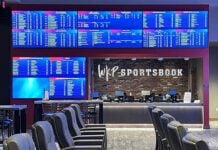by Andrew Klebanow
By any measure, 2020 was a catastrophic year for much of the world’s population. The pandemic’s effects have been particularly harsh on this country’s Indian tribes – thousands of people died, tens of thousands lost their jobs, and the loss of revenue from tribal gaming enterprises had a devastating effect on government services. Fortunately, as 2021 begins, there is light at the end of this dark tunnel in the form of vaccine distribution. Barring any significant setbacks, many of the most vulnerable will have been vaccinated by late spring, and the general population inoculated by mid-summer. As fears ease and the country approaches herd immunity, the gaming industry should be on a course to recovery by the fall.
One question that operators should begin to ask is, what has been learned from 2020? The shutdown of last spring, the subsequent re-opening under new health and safety protocols, and a reduction in gaming and non-gaming amenities forced managers to rethink everything about their businesses. Slot machine and table game capacity was reduced. Those amenities that could not operate under safety protocols, such as bingo halls, poker rooms, buffets, spas, valet parking, and entertainment venues were closed. Advertising spending was reduced, and promotions were scaled back. Over 160 Indian casinos implemented smoking bans to slow the spread of the virus. With a new sense of safety in place, loyal and avid customers returned. And they did so with far fewer incentives than they received in the past.
For many casino operators, another interesting trend emerged. While property revenues declined, operating margins dramatically improved. For some operators, net cash to the bottom line actually increased, sometimes noticeably. In other words, while business volume was down, cash flow went up. As the pandemic loses its grip on the nation and as people once again venture out in larger numbers for gaming entertainment, casino managers will cautiously re-open some outlets to meet business demand. Other amenities may remain closed, and there may be a slower return to past marketing and operating practices. Can this industry emerge as leaner and more efficient, or will it repeat the mistakes made during previous downturns?
Lessons from the Great Recession
When the gaming industry emerged from the effects of the great recession of 2009-2010, operators aggressively sought to regain market share, and grow topline gaming revenue. The goal was to bring in the bodies, fill the casino, and ‘peak the peak.’ Casino marketers beefed up their player reward programs, offering discounts and perks to players in the lower tiers of their databases. Advertising expense increased across all forms of media. Entertainment became a key driver to attract casual gamers and people who were not pre-disposed to gaming. Dining, particularly buffets, once again were used to drive people to casino properties. Casino capacity was increased so that there was always a sufficient number of games to accommodate visitors during peak holiday demand periods.
Player reinvestment, the amount spent on fostering loyalty and encouraging repeat visitation on people enrolled in casino player reward programs, increased substantially. Prior to the great recession, the player reinvestment rate (total player reinvestment expenses ÷ carded/tracked win) stood at around 20%, industry-wide. Post-recession, it increased to an average of 28%. By 2016, casinos nationwide were busy again. The increased spending succeeded in bringing in the bodies, oftentimes at a painful cost to operating margins.
What’s Next
As business returns to pre-pandemic levels, will casino operators immediately return to these aggressive business strategies, or will they take a more judicious approach, learning from this most devastating year? Discussions with operators in a number of jurisdictions revealed that many are not in any rush to return to past strategies. In fact, just as casino managers were forced to question everything about their businesses as the pandemic took hold, they are now looking at everything that was eliminated and deciding which amenities will come back and those that might not.
The Buffet
The pandemic forced the closure of buffets in almost every casino in America. The few that did re-open experimented with menus and food servers, but with little success. Others installed plexiglass shields, limited seating capacity, and enforced social distancing. Those that kept their buffets closed enjoyed a substantial improvement in overall food & beverage departmental performance. Buffets have been historically expensive to run and pricing before the pandemic rarely covered the buffet’s prime cost (food cost + labor cost). By keeping buffets closed, operating losses were reduced.
The pandemic will not bring an end to casino buffets. They serve an important role in the casino marketing mix. They can feed a large number of customers in a short amount of time, and many casino customers expect a buffet as part of their gaming experiences. What will change are buffet pricing strategies. Discounting will continue to be offered to premium tier players while lower tier customers will find themselves paying the retail price, and that price will probably be higher.
Player Reinvestment
Player reinvestment expenses are expected to come under close scrutiny. The era of awarding lower tiers of the database copious amounts of free play, food discounts and promotions may be coming to an end. Operators have learned during the pandemic that only the most profitable customers are deserving of high levels of player reinvestment. Those higher tier players will continue to receive generous free play offers, room offers, and invitations to special events.
Property Maintenance
While plexiglass dividers may not survive the post-pandemic era, cleanliness and property maintenance will. As facility engineers installed new air filtration systems to make their properties safer, many discovered that their old systems had become victims of deferred maintenance. They were filthy and ineffective at processing air. New air handling systems are expensive capital improvements and require strict maintenance programs. They will get maintained. Likewise, casino customers have come to appreciate the enhanced cleaning protocols implemented in public areas. While those orange shirts emblazoned with “clean team” logos are expected to disappear, cleanliness will not. Customers now expect sparkling clean restrooms, polished machines, fresh air, and overall cleanliness. Expect a renewed focus on property maintenance.
Smoking
Over 160 Indian casinos chose to prohibit smoking during the pandemic. The logic was clear: face masks become ineffective when they are lowered to allow cigarette smoking, and exhaling smoke distributes large droplets, and with them, the virus. While smoking in some form is expected to return, smoking sections are expected to be drastically reduced. Where prior to the pandemic, casinos allocated 90% of their floor space to smoking sections, the post-pandemic era is expected to reverse that allocation with the vast majority of casino floors designated as non-smoking. This will more closely match the percent of adults who smoke. Still, other operators are now considering maintaining property-wide smoking prohibitions. They have discovered that the diminution in gaming revenue was far less than feared, customer feedback has been positive, and their properties look cleaner and brighter. The era of the smoke-filled casino may be coming to an end.
Non-Core Amenities
Non-core amenities such as valet parking, poker and even bingo may be slow to return. One casino converted its valet parking lot to electric vehicle charging stations. Others re-allocated those prime parking spaces for premium tier players. Valet parking may not survive the pandemic.
Poker and bingo were cited as high-risk areas during the pandemic. When they closed, it was discovered in many cases that the cost of operating these gaming amenities was greater than the contributions they made to slot revenue. While
these Class II venues have long been considered essential to the overall gaming experience, their return may be postponed.
The pandemic has taught the industry that the Pareto Principle, commonly known as the 80/20 rule, still prevails, and a more targeted approach can yield better results.
Andrew Klebanow is a Principal at Klebanow Consulting and has worked in the casino industry since 1977 and as a gaming consultant since 2000. He can be reached by calling (702) 845-7346 or email [email protected].














































